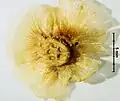| Halothamnus glaucus | |
|---|---|
 | |
| Scientific classification | |
| Kingdom: | Plantae |
| Clade: | Tracheophytes |
| Clade: | Angiosperms |
| Clade: | Eudicots |
| Order: | Caryophyllales |
| Family: | Amaranthaceae |
| Genus: | Halothamnus |
| Species: | H. glaucus |
| Binomial name | |
| Halothamnus glaucus | |
| Subspecies | |
|
3 subspecies, see text | |
Halothamnus glaucus is a species of the plant genus Halothamnus, that belongs to the subfamily Salsoloideae of the family Amaranthaceae, (formerly Chenopodiaceae). It occurs in Western and Central Asia.[1]
Morphology
Halothamnus glaucus is a sub-shrub up to 1 m high, with blueish-green pale-striped branches. The leaves are half-terete, fleshy, linear and up to 50 mm long and 0,7-2,0 mm wide. The bracts and bracteoles of the lower flowers are resembling the leaves, the bracts having basally wide membraneous margins. The flowers are 3,5-5,0 mm long with lanceolate-oval tepals, the stigmas are rounded at their tip. The winged fruit is 11–17 mm in diameter, their wings inserting in or something below the middle. The tube of the fruit is broadly cylindric, often dilated to its base, its bottom with circular-oval pits.[1][2]
 fruit (lateral view)
fruit (lateral view) fruit (bottom
fruit (bottom

The species comprises three subspecies: subsp. glaucus, glabrous, and the stamen filaments 0,6-0,9 mm wide; subsp. hispidulus, densely hairy, and the stamen filaments only 0,5-0,7 mm wide; and subsp. tianschanicus with truncate stigmas.[1][2]
Taxonomy

The species has been first described in 1798 by Friedrich August Marschall von Bieberstein as Salsola glauca (In: Tableau des provinces situées sur la côte occidentale de la Mer Caspienne, St. Pétersbourg, 1798, p. 112). In 1981, Victor Petrovič Botschantzev included it into the genus Halothamnus (In: Bot. Mater. Gerb. Bot. Inst. Komarova Akad. Nauk SSSR 18: p. 157). Within the genus, it belongs to section Halothamnus.[1][2]
Halothamnus glaucus is classified into three subspecies:[1][2]
- Halothamnus glaucus subsp. glaucus
Synonyms:
- Salsola glauca M.Bieb.
- Caroxylon glaucum (M.Bieb.) Moq.
- Aellenia glauca (M.Bieb.) Aellen
- Aellenia glauca (M.Bieb.) Aellen subsp. eu-glauca Aellen, nom.inval
- Aellenia glauca (M.Bieb.) Aellen subsp. glauca
- Aellenia glauca (M.Bieb.) Aellen subsp. eu-glauca Aellen f. reducta Aellen
- Salsola spicata Pall. (non Willd. 1798), nom.illeg
- Halothamnus heptapotamicus Botsch.
- Halothamnus glaucus subsp. hispidulus (Bunge) Kothe-Heinr.
Synonyms:
- Caroxylon hispidulum Bunge
- Salsola hispidula (Bunge) Boiss
- Salsola hispidula (Bunge) Bunge, nom.inval
- Aellenia glauca (M.Bieb.) Aellen ssp. hispidula (Bunge) Aellen
- Aellenia hispidula (Bunge) Botsch.
- Aellenia hispidula (Bunge) Aellen, nom. Inval
- Halothamnus hispidulus (Bunge) Botsch.
- Halothamnus glaucus subsp. tianschanicus (Botsch.) Kothe-Heinr.
Synonyms:
- Halothamnus tianschanicus Botsch.
Distribution
The distribution of Halothamnus glaucus extends from eastern Turkey[3] over Georgia, Armenia, Azerbaijan, Turkmenistan, northern Iran, Kazakhstan, Uzbekistan, Kyrgyzstan to China (Dzungaria, possibly Kashgaria) and Mongolia, too.[1][2] It grows in dry semideserts or mountain steppes on stony or clayey ground, partly on salty soils, up to 2000 m above sea-level.[1][2]
Cultivation and uses
Halothamnus glaucus is an important fodder plant for camels, sheep and goats[4] and is locally cultivated.[5] In former centuries, potash was extracted from the ash of the plants.[6] The roots and above ground parts of the plants are containing alkaloids.[7]
Vernacular names
References
- 1 2 3 4 5 6 7 Gabriele Kothe-Heinrich: Revision der Gattung Halothamnus (Chenopodiaceae). Bibliotheca Botanica Bd. 143, Schweizerbart, Stuttgart 1993, ISBN 978-3-510-48014-2, p. 101-112
- 1 2 3 4 5 6 Gabriele Kothe-Heinrich: Halothamnus. - In: Karl Heinz Rechinger et al. (Edit.): Flora Iranica Bd. 172, Chenopodiaceae - Akad. Druck, Graz 1997, ISBN 3-201-00728-5, p. 275-278 and fig. 7-8, tab. 154
- ↑ Helmut Freitag, Vagif Atamov, Esat Çetin, Mustafa Aslan: The genus Halothamnus Jaub. & Spach (Chenopodiaceae) in Turkey Archived 2011-08-19 at the Wayback Machine - Turk. J. Bot. 33, 2009: p. 325-334.
- ↑ G. K. Kinzikaeva: Aellenia. - In: P. N. Občinnikov (Hrsg.): Flora Tadžikskoj SSR 3: p.419-425. - Leningrad: Nauka, 1968
- 1 2 N. T. Nečaeva et al.: Žiznennye formy rastenij pustyni Karakumy. - Moskva: Izdat. "Nauka", 1973
- ↑ F. A. Marschall von Bieberstein: Tableau des provinces situées sur la côte occidentale de la Mer Caspienne (entre les fleuves Terek et Kour). - St. Pétersbourg 1798.
- ↑ T. A. Adylov: Âdovitye i alkaloidonosnye rasteniâ Karakulevodčeskich pastbiŝ Uzbekistana. - Taškent: Izdat. Fil. Akad. Nauk Uzbeksk. SSR, 1970.
- ↑ Â. M. Isaev: Chenopodiaceae. In: I. I. Karâgin (Ed.): Flora Azerbajdjana 3. - Baku: Izdat. Akad. Nauk Azerbajdjanskoj SSR., 1952
- ↑ A. Parsa: Flore de l'Iran 8: Index des noms vernaculaires locaux-latins. - Téhran: Publications de l'Université de Téhran. 1960
- ↑ Ž. Kurbanov: Konspekt flory zapadnych nizkogorij i srednegorij Kopetdaga (severo-zapadnyj Kopetdag i drugie nizkogoriâ zapadnoj Turkmenii). - Ašchabad: Izdat. "Ylym" 1988.
- ↑ Halothamnus glaucus in Flora of China
External links
 Media related to Halothamnus glaucus at Wikimedia Commons
Media related to Halothamnus glaucus at Wikimedia Commons Data related to Halothamnus glaucus at Wikispecies
Data related to Halothamnus glaucus at Wikispecies- "Halothamnus glaucus". Germplasm Resources Information Network. Agricultural Research Service, United States Department of Agriculture.
- "Halothamnus glaucus". National Center for Biotechnology Information (NCBI).
- Halothamnus glaucus at Tropicos
- Photos of Halothamnus glaucus at plantarium.ru